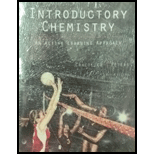
(a)
Interpretation:
Whether the statement “water can be made to boil at
Concept introduction:
The boiling point is defined as a temperature at which the conversion of a liquid into a vapor state takes place. At this temperature, the liquid’s vapor pressure becomes equal to the external pressure surrounding the liquid. The boiling point of a molecule depends upon the interactions that result from permanent or induced dipoles.
(b)
Interpretation:
Whether the statement “bubbles can form any place in a boiling liquid” is true or false is to be stated.
Concept introduction:
The boiling point is defined as a temperature at which the conversion of a liquid into a vapor state takes place. At this temperature, the liquid’s vapor pressure becomes equal to the external pressure surrounding the liquid. The boiling point of a molecule depends upon the interactions that result from permanent or induced dipoles.
Want to see the full answer?
Check out a sample textbook solution
Chapter 15 Solutions
Bundle: Introductory Chemistry: An Active Learning Approach, 6th + LMS Integrated for OWLv2, 4 terms (24 months) Printed Access Card
- The enthalpy of vaporization of water is larger than its enthalpy of fusion. Explain why.arrow_forwardA special vessel (see Fig. 10.45) contains ice and supercooled water (both at 10C) connected by vapor space. Describe what happens to the amounts of ice and water as time passes.arrow_forwardA representation of liquid water is shown below. Which of the three representations that follow best describes the water after it has boiled into steam?arrow_forward
- Identify the true statements about surface tension. Molecules along the surface of a liquid behave differently than those in the bulk liquid. Water forming a droplet as it falls from a faucet is a primary example of surface tension. Mercury has a lower surface tension than water. Surface tension increases as the temperature of the liquid rises. Cohesive forces attract the molecules of the liquid to one another.arrow_forwardIn each of the following groups of substances, pick the one that has the given property. Justify your answer. (a) highest boiling point Ne C12₂ HI Since this compound has ---Select--- (b) highest freezing point NH3 H₂O KCI Since this compound has ---Select--- unlike the other two compounds, it has the ---Select--- unlike the other two compounds, it has the ---Select--- (c) lowest vapor pressure at 25°C C12 12 F₂ Since all the molecules are ---Select--- and this molecule is ---Select--- than the other two, it has the intermolecular forces and will have the highest boiling point. intermolecular forces and will have the highest freezing point. ---Select--- ↑ ---Select--- (d) lowest freezing point H₂Se H₂ Cse2 Since this molecule is ---Select--- and ---Select--- than the other two, it has the ---Select--- ♥ ---Select--- and will have the lowest vapor pressure. and will have the lowest freezing point.arrow_forwardWhen a sample of 4°C water is cooled, it expands. remains unchanged. Not enough information is provided. contracts.arrow_forward
- What is the general relationship between the vapor pressure of a liquid and its temperature?arrow_forwardThere are three sets of sketches below, showing the same pure molecular compound (ammonia, molecular formula NH,) at three different temperatures. The sketches are drawn as if a sample of ammonia were under a microscope so powerful that individual atoms could be seen. Only one sketch in each set is correct. Use the slider to choose the correct sketch in each set. You may need the following information: melting point of NH3: – 77.7 °C boiling point of NH3: – 33.3 °C 00 A (Choose one) (Choose one) (Choose one) do 4 5 4 5. 21. °C - 60. °C - 89. °C Tra JAN .. W 14 ... MacBook Air DII DD 80 000 000 F11 F7 F8 F9 F10 F1 F4 F5 F6 F2 F3arrow_forwardA student is investigating the boiling and freezing point of a liquid, He observes the liquid in the apparatus while he gently heats the flask with a Bunsen burner flame. The liquid and its vapour are colorless and transparent. 1. Suggest one observation that will tell the student when the reading on the thermometer shows the boiling point of the liquid. 2. Explain why the temperature does not rise above its boiling point even though the flask is still being heated. Use the word thermal energy in your answer. 3. What effect on the boiling point is produced by a soluble non-volatile impurity, such as table salt, and an insoluble foreign substance, such as sand?arrow_forward
- Chemistry: Matter and ChangeChemistryISBN:9780078746376Author:Dinah Zike, Laurel Dingrando, Nicholas Hainen, Cheryl WistromPublisher:Glencoe/McGraw-Hill School Pub Co
 ChemistryChemistryISBN:9781305957404Author:Steven S. Zumdahl, Susan A. Zumdahl, Donald J. DeCostePublisher:Cengage Learning
ChemistryChemistryISBN:9781305957404Author:Steven S. Zumdahl, Susan A. Zumdahl, Donald J. DeCostePublisher:Cengage Learning Chemistry: The Molecular ScienceChemistryISBN:9781285199047Author:John W. Moore, Conrad L. StanitskiPublisher:Cengage Learning
Chemistry: The Molecular ScienceChemistryISBN:9781285199047Author:John W. Moore, Conrad L. StanitskiPublisher:Cengage Learning 
 Chemistry by OpenStax (2015-05-04)ChemistryISBN:9781938168390Author:Klaus Theopold, Richard H Langley, Paul Flowers, William R. Robinson, Mark BlaserPublisher:OpenStax
Chemistry by OpenStax (2015-05-04)ChemistryISBN:9781938168390Author:Klaus Theopold, Richard H Langley, Paul Flowers, William R. Robinson, Mark BlaserPublisher:OpenStax World of Chemistry, 3rd editionChemistryISBN:9781133109655Author:Steven S. Zumdahl, Susan L. Zumdahl, Donald J. DeCostePublisher:Brooks / Cole / Cengage Learning
World of Chemistry, 3rd editionChemistryISBN:9781133109655Author:Steven S. Zumdahl, Susan L. Zumdahl, Donald J. DeCostePublisher:Brooks / Cole / Cengage Learning





